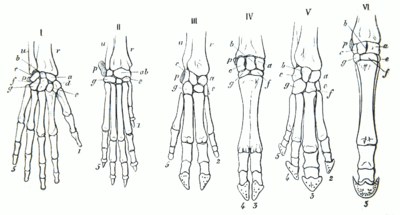Progression series (biology)
The terms progression series and regression series designate in comparative morphology an illustrative representation of the evolutionary development of organs or organ systems that have developed homologously .
definition
As a rule, progression denotes a structure that becomes more and more complicated, whereas regression denotes a structural simplification up to complete reduction.
Both effects often occur in parallel on an entire organism, a clear assignment to a certain series is often difficult, because both series (progression and regression series) can describe a specialization and thus a higher performance.
Since progression and regression series are an illustrative representation of evolution, it is often not the case in individual cases that the creatures shown actually descend genetically from one another. The living beings shown, however, represent exemplary forms of development that are imagined as successive in a temporal and evolutionary sequence. Progression series often gives the misleading impression that evolution proceeds in stages. However, this is due to the simplified representation.
Examples
The recent snakes are an example of a complete loss of an organ, their legs are functionally completely reduced.
Another example of a progression and regression series is the evolution of horses . Three development trends can be identified:
- Reduction of the number of toes (regression)
- Development of high-crowned, rootless teeth (progression)
- and an increase in height (progression).
At the beginning of the development there are forms like the fox-sized, four-toed Hyracotherium (formerly " Eohippus "). The development goes through many intermediate forms (e.g. Mesohippus , Merychippus , Pliohippus ) to the recent single-toed horse ( Equus ).
A parallel to this is the horse's bite : Hyracotherium's low-crowned teeth, suitable for eating soft plant food such as leaves ( folivory ), have developed into the high-crowned teeth of today's horses that feed on hard grasses .

